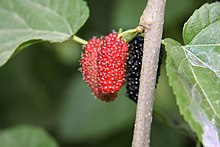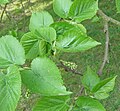From Wikipedia, the free encyclopedia
"Mulberry" redirects here. For other uses, see Mulberry (disambiguation).
| Mulberry | |
|---|---|
 | |
| Morus nigra | |
| Scientific classification | |
| Kingdom: | Plantae |
| (unranked): | Angiosperms |
| (unranked): | Eudicots |
| (unranked): | Rosids |
| Order: | Rosales |
| Family: | Moraceae |
| Tribe: | Moreae[1] |
| Genus: | Morus L. |
| Species | |
See text.
| |
Morus, a genus of flowering plants in the family Moraceae, comprises 10–16 species of deciduous trees commonly known as mulberries growing wild and under cultivation in many temperate world regions.[2]
The closely related genus Broussonetia is also commonly known as mulberry, notably the Paper Mulberry, Broussonetia papyrifera. Mulberries are swift-growing when young, but soon become slow-growing and rarely exceed 10–15 m (33–49 ft) tall. The leaves are alternately arranged, simple, often lobed, more often lobed on juvenile shoots than on mature trees, and serrated on the margin.
The mulberry fruit is a multiple fruit, 2–3 cm (0.79–1.18 in) long. Immature fruits are white, green, or pale yellow. In most species, the fruits turn pink and then red while ripening, then dark purple or black, and have a sweet flavor when fully ripe. The fruits of the white-fruited cultivar are white when ripe; the fruit in this cultivar is also sweet but has a very mild flavor compared with the darker variety.
Contents
[hide]Species[edit]
The taxonomy of Morus is complex and disputed. Over 150 species names have been published, and although differing sources may cite different selections of accepted names, only 10–16 are generally cited as being accepted by the vast majority of botanical authorities. Morus classification is even further complicated by widespreadhybridisation, wherein the hybrids are fertile.
The following species are generally accepted:
- Morus alba L. – White Mulberry (E Asia)
- Morus australis Poir. – Chinese Mulberry (SE Asia)
- Morus celtidifolia Kunth (Mexico)
- Morus insignis (S America)
- Morus mesozygia Stapf – African Mulberry (S and C Africa)
- Morus microphylla – Texas Mulberry(Mexico, Texas (USA))
- Morus nigra L. – Black Mulberry (SW Asia)
- Morus rubra L. – Red Mulberry (E N America)
The following, all from eastern and southern Asia, are additionally accepted by one or more taxonomic lists or studies; synonymy, as given by other lists or studies, is indicated in square brackets:
- Morus atropurpurea [M. alba var. alba]
- Morus bombycis [M. australis]
- Morus cathayana
- Morus indica [M. alba]
- Morus japonica [M. alba]
- Morus kagayamae [M. australis]
- Morus laevigata [M. alba var.laevigata; M. macroura]
- Morus latifolia [M. alba]
- Morus liboensis
- Morus macroura [M. alba var.laevigata]
- Morus mongolica [M. alba var.mongolica]
- Morus multicaulis [M. alba var.multicaulis]
- Morus notabilis
- Morus rotundiloba
- Morus serrata [M. alba var. serrata], Himalayan mulberry
- Morus tillaefolia
- Morus trilobata [M. australis var. trilobata]
- Morus wittiorum
Uses and cultivation[edit]
The ripe fruit is edible and is widely used in pies, tarts, wines, cordials and tea. The fruit of the black mulberry, native to southwest Asia, and the red mulberry, native to eastern North America, have the strongest flavor, which has been likened to 'fireworks in the mouth'.[5]
The fruit of the white mulberry, an east Asian species which is extensively naturalized in urban regions of eastern North America, has a different flavor, sometimes characterized as refreshing and a little tart, with a bit of gumminess to it and a hint of vanilla.[6][7] In North America the white mulberry is considered an invasive exotic and has taken over extensive tracts from native plant species, including the red mulberry.[8] The mature plant contains significant amounts of resveratrol, particularly in stem bark.[9] The fruit and leaves are sold in various forms as nutritional supplements. Unripe fruit and green parts of the plant have a white sap that may be toxic, stimulating, or mildly hallucinogenic.[10]
Black, red, and white mulberry are widespread in southern Europe, the Middle East, northern Africa and Indian Subcontinentwhere the tree and the fruit have names under regional dialects. Jams and sherbets are often made from the fruit in this region. Black mulberry was imported to Britain in the 17th century in the hope that it would be useful in the cultivation of silkworms. It was much used in folk medicine, especially in the treatment of ringworm. Mulberries are also widespread inGreece, particularly in the Peloponnese, which in the Middle Ages was known as Morea (Greek: Μωριάς, Morias), deriving from the Greek word for the tree (Greek: Μουριά, Μouria).
Mulberries can be grown from seed, and this is often advised as seedling-grown trees are generally of better shape and health, but they are most often planted from large cuttings which root readily. The mulberry plants which are allowed to grow tall with a crown height of 5–6 feet from ground level and a stem girth of 4–5 inches or more is called tree mulberry. They are specially raised with the help of well-grown saplings 8–10 months old of any of the varieties recommended for rain-fed areas like S-13 (for red loamy soil) or S-34 (black cotton soil) which are tolerant to drought or soil-moisture stress conditions. Usually, the plantation is raised and in block formation with a spacing of 6 feet x 6 feet, or 8 feet x 8 feet, as plant to plant and row to row distance. The plants are usually pruned once a year during the monsoon season (July – August) to a height of 5–6 feet and allowed to grow with a maximum of 8–10 shoots at the crown. The leaves are harvested 3–4 times a year by a leaf picking method[clarification needed] under rain-fed or semi-arid conditions, depending on the monsoon.
The tree branches pruned during the fall season (after the leaves have fallen) are cut and used to make durable baskets supporting agriculture and animal husbandry.
Some North American cities have banned the planting of mulberries because of the large amounts of pollen they produce, posing a potential health hazard for some pollen allergy sufferers.[11] In actuality, it is only the male mulberry trees that produce pollen; this light-weight pollen can be inhaled deeply into the lungs, sometimes triggering asthma.[12][13] Conversely, female mulberry trees produce all-female flowers, which draw pollen and dust from the air. Because of this pollen-absorbing feature, all-female mulberry trees have an OPALS allergy scale rating of just 1, and are considered "allergy-free".[12]
Fortunately, mulberry tree scion wood can easily be grafted onto other mulberry trees during the winter, when the tree is dormant. One common scenario is converting a problematic male mulberry tree to an allergy-free female tree, by grafting all-female mulberry tree scions to a male mulberry that has been pruned back hard.[14] However, any new growth from below the graft(s) must be removed, as they would be from the original male mulberry tree.[15]
Silk industry[edit]
Mulberry leaves, particularly those of the white mulberry, are ecologically important as the sole food source of the silkworm (Bombyx mori, named after the mulberry genus Morus), the pupa/cocoon of which is used to make silk.[16][17] OtherLepidoptera larvae—which include the common emerald, the lime hawk-moth, and the sycamore moth—also sometimes eat the plant.
Pigments[edit]
Mulberry fruit color derives from anthocyanins which are under basic research for mechanisms of various diseases.[18][19] Anthocyanins are responsible for the attractive colors of fresh plant foods, including orange, red, purple, black, and blue. These colors are water-soluble and easily extractable, yielding natural food colorants. Due to a growing demand for natural food colorants, their significance in the food industry is increasing.
A cheap and industrially feasible method has been developed to extract anthocyanins from mulberry fruit which could be used as a fabric tanning agent or food colorant of high color value (above 100). Scientists found that, of thirty-one Chinese mulberry cultivars tested, the total anthocyanin yield varied from 148 mg to 2725 mg per liter of fruit juice.[20] It was also found that all the sugars, acids, and vitamins of the fruit remained intact in the residual juice after removal of the anthocyanins, so the juice could be used to produce products such as juice, wine, and sauce.
Anthocyanin content depends on climate and area of cultivation and is particularly high in sunny climates.[21] This finding holds promise for tropical countries that grow mulberry trees as part of the practice of sericulture to profit from industrial anthocyanin production through the recovery of anthocyanins from the mulberry fruit.
This offers a challenging task to the mulberry germplasm resources for
- exploration and collection of fruit yielding mulberry species;
- their characterization, cataloging, and evaluation for anthocyanin content by using traditional as well as modern means and biotechnology tools;
- developing an information system about these cultivars or varieties;
- training and global coordination of genetic stocks;
- evolving suitable breeding strategies to improve the anthocyanin content in potential breeds by collaboration with various research stations in the field of sericulture, plant genetics, and breeding, biotechnology and pharmacology.
In popular culture[edit]
The nursery rhyme Here We Go Round the Mulberry Bush uses the tree in the refrain, as do some contemporary American versions of the nursery rhyme Pop Goes the Weasel. Vincent van Gogh featured the mulberry tree in some of his paintings, notably "Mulberry Tree."[22]
The Roman mythological tale of Pyramus and Thisbe provides a story of the mulberry fruit's color. According to the tale, after the two lovers die tragically, the gods listen to Thisbe's lament and forever change the color of the mulberry fruits into their red stained color to honor the forbidden love.



























Collagen key to close that pore In the hopes that it will “heal their gut” and improve digestion. It is no secret that what we put into our body’s plays a primary role in a happy healthy life, which is why collagen is the perfect addition. Studies have shown that collagen can help aid digestion, reduce gut inflammation, heal stomach ulcers, and regulate acid secretion.
ReplyDeleteThis comment has been removed by the author.
ReplyDelete